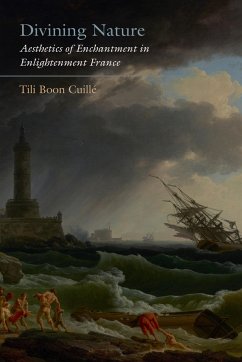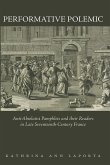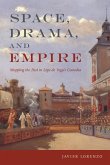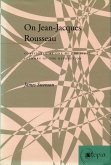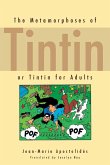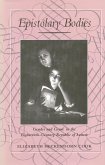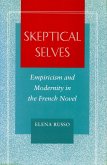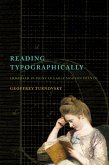- Gebundenes Buch
- Merkliste
- Auf die Merkliste
- Bewerten Bewerten
- Teilen
- Produkt teilen
- Produkterinnerung
- Produkterinnerung
"Divining Nature traces the philosophical, aesthetic, and affective responses to the "spectacle of nature" across the arts and sciences in eighteenth-century France to uncover the preservation and proliferation of wonder in the age of reason"--
Andere Kunden interessierten sich auch für
![Performative Polemic Performative Polemic]() Kathrina Ann LaportaPerformative Polemic180,99 €
Kathrina Ann LaportaPerformative Polemic180,99 €![Space, Drama, and Empire Space, Drama, and Empire]() Javier LorenzoSpace, Drama, and Empire178,99 €
Javier LorenzoSpace, Drama, and Empire178,99 €![On Jean-Jacques Rousseau On Jean-Jacques Rousseau]() James SwensonOn Jean-Jacques Rousseau167,99 €
James SwensonOn Jean-Jacques Rousseau167,99 €![The Metamorphoses of Tintin The Metamorphoses of Tintin]() Jean-Marie ApostolidèsThe Metamorphoses of Tintin141,99 €
Jean-Marie ApostolidèsThe Metamorphoses of Tintin141,99 €![Epistolary Bodies Epistolary Bodies]() Elizabeth Heckendorn CookEpistolary Bodies78,99 €
Elizabeth Heckendorn CookEpistolary Bodies78,99 €![Skeptical Selves Skeptical Selves]() Elena RussoSkeptical Selves84,99 €
Elena RussoSkeptical Selves84,99 €![Reading Typographically Reading Typographically]() Geoffrey TurnovskyReading Typographically84,99 €
Geoffrey TurnovskyReading Typographically84,99 €-
-
-
"Divining Nature traces the philosophical, aesthetic, and affective responses to the "spectacle of nature" across the arts and sciences in eighteenth-century France to uncover the preservation and proliferation of wonder in the age of reason"--
Hinweis: Dieser Artikel kann nur an eine deutsche Lieferadresse ausgeliefert werden.
Hinweis: Dieser Artikel kann nur an eine deutsche Lieferadresse ausgeliefert werden.
Produktdetails
- Produktdetails
- Verlag: Stanford University Press
- Seitenzahl: 350
- Erscheinungstermin: 15. Dezember 2020
- Englisch
- Abmessung: 231mm x 152mm x 28mm
- Gewicht: 590g
- ISBN-13: 9781503613362
- ISBN-10: 1503613364
- Artikelnr.: 58662783
- Herstellerkennzeichnung
- Produktsicherheitsverantwortliche/r
- Europaallee 1
- 36244 Bad Hersfeld
- gpsr@libri.de
- Verlag: Stanford University Press
- Seitenzahl: 350
- Erscheinungstermin: 15. Dezember 2020
- Englisch
- Abmessung: 231mm x 152mm x 28mm
- Gewicht: 590g
- ISBN-13: 9781503613362
- ISBN-10: 1503613364
- Artikelnr.: 58662783
- Herstellerkennzeichnung
- Produktsicherheitsverantwortliche/r
- Europaallee 1
- 36244 Bad Hersfeld
- gpsr@libri.de
Tili Boon Cuillé is Associate Professor of French and Comparative Literature at Washington University in St. Louis. She is the author of Narrative Interludes: Musical Tableaux in Eighteenth-Century French Texts (2006).
Contents and Abstracts
Introduction: The Spectacle of Nature
chapter abstract
Opening with the Abbé Pluche's best selling Spectacle de la nature, the
introduction distinguishes characterizations of nature as book, clock, and
spectacle. Questioning lingering associations of the Enlightenment with
disenchantment, it considers the fate of the marvelous in
eighteenth-century France. Affective responses to nature's
spectacle-traditionally associated with religion or religious
fanaticism-including wonder, enthusiasm, and melancholy, were
systematically linked to the faculties of reason, imagination, and memory
that structured Diderot and D'Alembert's Encyclopédie. The introduction
lays the groundwork for this study by surveying developments in
Enlightenment science and aesthetics, particularly empiricism,
sensationalism, vitalism, and the theorization of the sublime, traced not
to Longinus but to Lucretius.
1The Marvels of Nature in Buffon and Rameau
chapter abstract
Taking Fontenelle's famed comparison of nature to the opera somewhat
literally, Chapter 1 considers the representation of natural phenomena in
the Comte de Buffon's Histoire naturelle and Jean-Philippe Rameau's opera
Zoroastre, which coincided in 1749. Lorraine Daston and Katherine Park have
argued that wonder gave way to a more scientific curiosity in the
Enlightenment. This chapter demonstrates that Buffon and Rameau to the
contrary sought to sustain the wonder of the reader/spectator when
confronted with natural marvels on the page and the stage. Wonder
constituted the affective counterpart to encounters with the marvelous,
which Rameau's librettist Louis de Cahusac considered a defining feature of
French tragic opera. The chapter likens plans for the improvement of
special effects, the renovation of the opera, and the establishment of the
National Museum of Natural History in the course of the century, designed
to reconcile enlightenment and enchantment.
2The Philosophy of Nature in Diderot and Rousseau
chapter abstract
Denis Diderot and Jean-Jacques Rousseau were avid readers of Buffon's
Histoire naturelle and active participants in the quarrels prompted by
Rameau's operas. To date, scholarship has focused primarily on their
theorization of physiological and moral sensibility. Chapter 2 investigates
Diderot's and Rousseau's response to the spectacle of nature, focusing on
the affinity between the inspiration of the artist and the identification
of the spectator. Jan Goldstein has characterized "enthusiasm" and
"imagination" as eighteenth-century smear words. These terms are
recuperated in Diderot's writings on painting and the theater and
Rousseau's writings on opera and the novel, however. Enthusiasm, like pity,
necessitates a movement outside oneself that facilitates union with the
other and the forging of the ideal model. The chapter concludes by
considering the alternate forms of natural spectacle that Diderot and
Rousseau envision in their writings.
3The Harmony of Nature in Paul et Virginie
chapter abstract
Rousseau's protégé, Jacques-Henri Bernardin de Saint-Pierre, conceived of
his Études de la nature as a complement to Buffon's Histoire naturelle.
Chapter 3 traces the generation of his novel Paul et Virginie from his
travelogue to its publication as the fourth book of his natural history.
Bernard de Lacépède's Poétique de la musique provides a missing link
between Bernardin's novel and its operatic adaptation by Jean-François Le
Sueur. Reading Bernardin's natural history, full of advice for artists,
alongside Le Sueur's essays on church music, full of tips for composers,
reveals that author and composer both sustained and sought to foster mixed
emotions in response to the spectacle of nature that led to the "sentiment
of divinity." The chapter concludes with a consideration of French
cathedrals, redesigned along lines reminiscent of the opera and the natural
history museum in the course of the century.
4The Poetics of Nature in Ossian and Staël
chapter abstract
France's frame of reference shifted northward when James Macpherson went in
search of the Scots national epic, returning with poems attributed to the
third-century bard Ossian. Though denounced as a hoax, Macpherson's
reconstruction of a lost epic from surviving fragments has since been
compared to scientific endeavors such as geology and cartography. Chapter 4
explores Macpherson's use of similes interrelating the natural and the
spiritual realms and the relationship between melancholy and memory in the
epics before turning to their favorable French reception. Both Napoleon and
Germaine de Staël embraced France's northern heritage, hailing Ossian as
the new Homer. Privileging northern melancholy over southern enthusiasm,
Staël looked to the philosophical poetry of the north as the source of
French spiritual regeneration. Ironically, anxieties about the epics'
authenticity led to the establishment of the Académie Celtique and the
science of folklore.
Epilogue: A Theater of Enchantment
chapter abstract
The epilogue considers E.T.A. Hoffmann and François-René de Chateaubriand's
retrospective reflections on the marvelous in art and nature. Evidence that
the marvelous survived the century can be found in the glories used to
transport Greek gods, Christian angels, and Scots ghosts in opera, on
altarpieces, and in history painting. The cognitive and emotional responses
to the spectacle of nature, including wonder, enthusiasm, melancholy, and
the "sentiment of divinity," which contributed to the theorization of the
sublime, also pertain to current discussions of environmental aesthetics.
chapter abstract
Introduction: The Spectacle of Nature
chapter abstract
Opening with the Abbé Pluche's best selling Spectacle de la nature, the
introduction distinguishes characterizations of nature as book, clock, and
spectacle. Questioning lingering associations of the Enlightenment with
disenchantment, it considers the fate of the marvelous in
eighteenth-century France. Affective responses to nature's
spectacle-traditionally associated with religion or religious
fanaticism-including wonder, enthusiasm, and melancholy, were
systematically linked to the faculties of reason, imagination, and memory
that structured Diderot and D'Alembert's Encyclopédie. The introduction
lays the groundwork for this study by surveying developments in
Enlightenment science and aesthetics, particularly empiricism,
sensationalism, vitalism, and the theorization of the sublime, traced not
to Longinus but to Lucretius.
1The Marvels of Nature in Buffon and Rameau
chapter abstract
Taking Fontenelle's famed comparison of nature to the opera somewhat
literally, Chapter 1 considers the representation of natural phenomena in
the Comte de Buffon's Histoire naturelle and Jean-Philippe Rameau's opera
Zoroastre, which coincided in 1749. Lorraine Daston and Katherine Park have
argued that wonder gave way to a more scientific curiosity in the
Enlightenment. This chapter demonstrates that Buffon and Rameau to the
contrary sought to sustain the wonder of the reader/spectator when
confronted with natural marvels on the page and the stage. Wonder
constituted the affective counterpart to encounters with the marvelous,
which Rameau's librettist Louis de Cahusac considered a defining feature of
French tragic opera. The chapter likens plans for the improvement of
special effects, the renovation of the opera, and the establishment of the
National Museum of Natural History in the course of the century, designed
to reconcile enlightenment and enchantment.
2The Philosophy of Nature in Diderot and Rousseau
chapter abstract
Denis Diderot and Jean-Jacques Rousseau were avid readers of Buffon's
Histoire naturelle and active participants in the quarrels prompted by
Rameau's operas. To date, scholarship has focused primarily on their
theorization of physiological and moral sensibility. Chapter 2 investigates
Diderot's and Rousseau's response to the spectacle of nature, focusing on
the affinity between the inspiration of the artist and the identification
of the spectator. Jan Goldstein has characterized "enthusiasm" and
"imagination" as eighteenth-century smear words. These terms are
recuperated in Diderot's writings on painting and the theater and
Rousseau's writings on opera and the novel, however. Enthusiasm, like pity,
necessitates a movement outside oneself that facilitates union with the
other and the forging of the ideal model. The chapter concludes by
considering the alternate forms of natural spectacle that Diderot and
Rousseau envision in their writings.
3The Harmony of Nature in Paul et Virginie
chapter abstract
Rousseau's protégé, Jacques-Henri Bernardin de Saint-Pierre, conceived of
his Études de la nature as a complement to Buffon's Histoire naturelle.
Chapter 3 traces the generation of his novel Paul et Virginie from his
travelogue to its publication as the fourth book of his natural history.
Bernard de Lacépède's Poétique de la musique provides a missing link
between Bernardin's novel and its operatic adaptation by Jean-François Le
Sueur. Reading Bernardin's natural history, full of advice for artists,
alongside Le Sueur's essays on church music, full of tips for composers,
reveals that author and composer both sustained and sought to foster mixed
emotions in response to the spectacle of nature that led to the "sentiment
of divinity." The chapter concludes with a consideration of French
cathedrals, redesigned along lines reminiscent of the opera and the natural
history museum in the course of the century.
4The Poetics of Nature in Ossian and Staël
chapter abstract
France's frame of reference shifted northward when James Macpherson went in
search of the Scots national epic, returning with poems attributed to the
third-century bard Ossian. Though denounced as a hoax, Macpherson's
reconstruction of a lost epic from surviving fragments has since been
compared to scientific endeavors such as geology and cartography. Chapter 4
explores Macpherson's use of similes interrelating the natural and the
spiritual realms and the relationship between melancholy and memory in the
epics before turning to their favorable French reception. Both Napoleon and
Germaine de Staël embraced France's northern heritage, hailing Ossian as
the new Homer. Privileging northern melancholy over southern enthusiasm,
Staël looked to the philosophical poetry of the north as the source of
French spiritual regeneration. Ironically, anxieties about the epics'
authenticity led to the establishment of the Académie Celtique and the
science of folklore.
Epilogue: A Theater of Enchantment
chapter abstract
The epilogue considers E.T.A. Hoffmann and François-René de Chateaubriand's
retrospective reflections on the marvelous in art and nature. Evidence that
the marvelous survived the century can be found in the glories used to
transport Greek gods, Christian angels, and Scots ghosts in opera, on
altarpieces, and in history painting. The cognitive and emotional responses
to the spectacle of nature, including wonder, enthusiasm, melancholy, and
the "sentiment of divinity," which contributed to the theorization of the
sublime, also pertain to current discussions of environmental aesthetics.
chapter abstract
Contents and Abstracts
Introduction: The Spectacle of Nature
chapter abstract
Opening with the Abbé Pluche's best selling Spectacle de la nature, the
introduction distinguishes characterizations of nature as book, clock, and
spectacle. Questioning lingering associations of the Enlightenment with
disenchantment, it considers the fate of the marvelous in
eighteenth-century France. Affective responses to nature's
spectacle-traditionally associated with religion or religious
fanaticism-including wonder, enthusiasm, and melancholy, were
systematically linked to the faculties of reason, imagination, and memory
that structured Diderot and D'Alembert's Encyclopédie. The introduction
lays the groundwork for this study by surveying developments in
Enlightenment science and aesthetics, particularly empiricism,
sensationalism, vitalism, and the theorization of the sublime, traced not
to Longinus but to Lucretius.
1The Marvels of Nature in Buffon and Rameau
chapter abstract
Taking Fontenelle's famed comparison of nature to the opera somewhat
literally, Chapter 1 considers the representation of natural phenomena in
the Comte de Buffon's Histoire naturelle and Jean-Philippe Rameau's opera
Zoroastre, which coincided in 1749. Lorraine Daston and Katherine Park have
argued that wonder gave way to a more scientific curiosity in the
Enlightenment. This chapter demonstrates that Buffon and Rameau to the
contrary sought to sustain the wonder of the reader/spectator when
confronted with natural marvels on the page and the stage. Wonder
constituted the affective counterpart to encounters with the marvelous,
which Rameau's librettist Louis de Cahusac considered a defining feature of
French tragic opera. The chapter likens plans for the improvement of
special effects, the renovation of the opera, and the establishment of the
National Museum of Natural History in the course of the century, designed
to reconcile enlightenment and enchantment.
2The Philosophy of Nature in Diderot and Rousseau
chapter abstract
Denis Diderot and Jean-Jacques Rousseau were avid readers of Buffon's
Histoire naturelle and active participants in the quarrels prompted by
Rameau's operas. To date, scholarship has focused primarily on their
theorization of physiological and moral sensibility. Chapter 2 investigates
Diderot's and Rousseau's response to the spectacle of nature, focusing on
the affinity between the inspiration of the artist and the identification
of the spectator. Jan Goldstein has characterized "enthusiasm" and
"imagination" as eighteenth-century smear words. These terms are
recuperated in Diderot's writings on painting and the theater and
Rousseau's writings on opera and the novel, however. Enthusiasm, like pity,
necessitates a movement outside oneself that facilitates union with the
other and the forging of the ideal model. The chapter concludes by
considering the alternate forms of natural spectacle that Diderot and
Rousseau envision in their writings.
3The Harmony of Nature in Paul et Virginie
chapter abstract
Rousseau's protégé, Jacques-Henri Bernardin de Saint-Pierre, conceived of
his Études de la nature as a complement to Buffon's Histoire naturelle.
Chapter 3 traces the generation of his novel Paul et Virginie from his
travelogue to its publication as the fourth book of his natural history.
Bernard de Lacépède's Poétique de la musique provides a missing link
between Bernardin's novel and its operatic adaptation by Jean-François Le
Sueur. Reading Bernardin's natural history, full of advice for artists,
alongside Le Sueur's essays on church music, full of tips for composers,
reveals that author and composer both sustained and sought to foster mixed
emotions in response to the spectacle of nature that led to the "sentiment
of divinity." The chapter concludes with a consideration of French
cathedrals, redesigned along lines reminiscent of the opera and the natural
history museum in the course of the century.
4The Poetics of Nature in Ossian and Staël
chapter abstract
France's frame of reference shifted northward when James Macpherson went in
search of the Scots national epic, returning with poems attributed to the
third-century bard Ossian. Though denounced as a hoax, Macpherson's
reconstruction of a lost epic from surviving fragments has since been
compared to scientific endeavors such as geology and cartography. Chapter 4
explores Macpherson's use of similes interrelating the natural and the
spiritual realms and the relationship between melancholy and memory in the
epics before turning to their favorable French reception. Both Napoleon and
Germaine de Staël embraced France's northern heritage, hailing Ossian as
the new Homer. Privileging northern melancholy over southern enthusiasm,
Staël looked to the philosophical poetry of the north as the source of
French spiritual regeneration. Ironically, anxieties about the epics'
authenticity led to the establishment of the Académie Celtique and the
science of folklore.
Epilogue: A Theater of Enchantment
chapter abstract
The epilogue considers E.T.A. Hoffmann and François-René de Chateaubriand's
retrospective reflections on the marvelous in art and nature. Evidence that
the marvelous survived the century can be found in the glories used to
transport Greek gods, Christian angels, and Scots ghosts in opera, on
altarpieces, and in history painting. The cognitive and emotional responses
to the spectacle of nature, including wonder, enthusiasm, melancholy, and
the "sentiment of divinity," which contributed to the theorization of the
sublime, also pertain to current discussions of environmental aesthetics.
chapter abstract
Introduction: The Spectacle of Nature
chapter abstract
Opening with the Abbé Pluche's best selling Spectacle de la nature, the
introduction distinguishes characterizations of nature as book, clock, and
spectacle. Questioning lingering associations of the Enlightenment with
disenchantment, it considers the fate of the marvelous in
eighteenth-century France. Affective responses to nature's
spectacle-traditionally associated with religion or religious
fanaticism-including wonder, enthusiasm, and melancholy, were
systematically linked to the faculties of reason, imagination, and memory
that structured Diderot and D'Alembert's Encyclopédie. The introduction
lays the groundwork for this study by surveying developments in
Enlightenment science and aesthetics, particularly empiricism,
sensationalism, vitalism, and the theorization of the sublime, traced not
to Longinus but to Lucretius.
1The Marvels of Nature in Buffon and Rameau
chapter abstract
Taking Fontenelle's famed comparison of nature to the opera somewhat
literally, Chapter 1 considers the representation of natural phenomena in
the Comte de Buffon's Histoire naturelle and Jean-Philippe Rameau's opera
Zoroastre, which coincided in 1749. Lorraine Daston and Katherine Park have
argued that wonder gave way to a more scientific curiosity in the
Enlightenment. This chapter demonstrates that Buffon and Rameau to the
contrary sought to sustain the wonder of the reader/spectator when
confronted with natural marvels on the page and the stage. Wonder
constituted the affective counterpart to encounters with the marvelous,
which Rameau's librettist Louis de Cahusac considered a defining feature of
French tragic opera. The chapter likens plans for the improvement of
special effects, the renovation of the opera, and the establishment of the
National Museum of Natural History in the course of the century, designed
to reconcile enlightenment and enchantment.
2The Philosophy of Nature in Diderot and Rousseau
chapter abstract
Denis Diderot and Jean-Jacques Rousseau were avid readers of Buffon's
Histoire naturelle and active participants in the quarrels prompted by
Rameau's operas. To date, scholarship has focused primarily on their
theorization of physiological and moral sensibility. Chapter 2 investigates
Diderot's and Rousseau's response to the spectacle of nature, focusing on
the affinity between the inspiration of the artist and the identification
of the spectator. Jan Goldstein has characterized "enthusiasm" and
"imagination" as eighteenth-century smear words. These terms are
recuperated in Diderot's writings on painting and the theater and
Rousseau's writings on opera and the novel, however. Enthusiasm, like pity,
necessitates a movement outside oneself that facilitates union with the
other and the forging of the ideal model. The chapter concludes by
considering the alternate forms of natural spectacle that Diderot and
Rousseau envision in their writings.
3The Harmony of Nature in Paul et Virginie
chapter abstract
Rousseau's protégé, Jacques-Henri Bernardin de Saint-Pierre, conceived of
his Études de la nature as a complement to Buffon's Histoire naturelle.
Chapter 3 traces the generation of his novel Paul et Virginie from his
travelogue to its publication as the fourth book of his natural history.
Bernard de Lacépède's Poétique de la musique provides a missing link
between Bernardin's novel and its operatic adaptation by Jean-François Le
Sueur. Reading Bernardin's natural history, full of advice for artists,
alongside Le Sueur's essays on church music, full of tips for composers,
reveals that author and composer both sustained and sought to foster mixed
emotions in response to the spectacle of nature that led to the "sentiment
of divinity." The chapter concludes with a consideration of French
cathedrals, redesigned along lines reminiscent of the opera and the natural
history museum in the course of the century.
4The Poetics of Nature in Ossian and Staël
chapter abstract
France's frame of reference shifted northward when James Macpherson went in
search of the Scots national epic, returning with poems attributed to the
third-century bard Ossian. Though denounced as a hoax, Macpherson's
reconstruction of a lost epic from surviving fragments has since been
compared to scientific endeavors such as geology and cartography. Chapter 4
explores Macpherson's use of similes interrelating the natural and the
spiritual realms and the relationship between melancholy and memory in the
epics before turning to their favorable French reception. Both Napoleon and
Germaine de Staël embraced France's northern heritage, hailing Ossian as
the new Homer. Privileging northern melancholy over southern enthusiasm,
Staël looked to the philosophical poetry of the north as the source of
French spiritual regeneration. Ironically, anxieties about the epics'
authenticity led to the establishment of the Académie Celtique and the
science of folklore.
Epilogue: A Theater of Enchantment
chapter abstract
The epilogue considers E.T.A. Hoffmann and François-René de Chateaubriand's
retrospective reflections on the marvelous in art and nature. Evidence that
the marvelous survived the century can be found in the glories used to
transport Greek gods, Christian angels, and Scots ghosts in opera, on
altarpieces, and in history painting. The cognitive and emotional responses
to the spectacle of nature, including wonder, enthusiasm, melancholy, and
the "sentiment of divinity," which contributed to the theorization of the
sublime, also pertain to current discussions of environmental aesthetics.
chapter abstract

